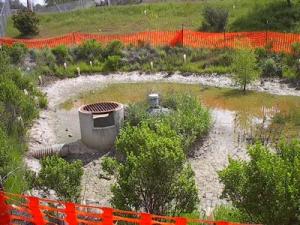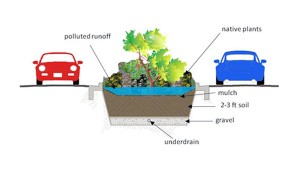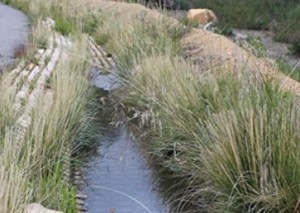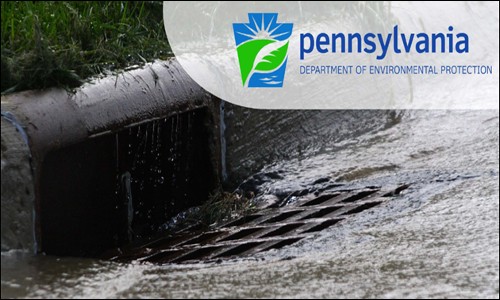On Saturday I wrote about the DEP’s newest mandate that will require all communities to reduce sediment and pollution runoff by 10 percent. It’s part of a new requirement for the Federal Mandated MS4 program in order to get a permit renewal that will be good until 2023.
West Easton may have to meet that requirement out-of-pocket, unless the political winds change and grants become available to pay for the few options we have, that will appease the DEP.
In order for the public to understand what MS4 is, because you may be hearing that designation referenced often during the next year, what follows are the basics.
Multiple Separate Stormwater Sewer System (MS4) is supposedly monitored by the DEP to see how our borough manages infrastructure to collect, convey, and discharge stormwater.
Originally, there was nothing more to a stormwater system than the intent to prevent water from flooding streets. Over time, that changed due to people dumping chemicals and other pollutants into stormwater drains. What these stormwater drains collect go untreated into rivers and streams.
Eventually, the EPA stepped in and directed state DEP’s oversee stormwater systems. By December 2002, DEP issued a General Permit (“PAG-13”) for use by MS4s that fall under the National Pollutant Discharge Elimination System (NPDES) Phase II program, requiring communities to implement a stormwater management program for minimizing the impacts from runoff. Several extensions have occurred since the expiry of the initial 5-year NPDES permit period.
Under the MS4 Program, permittees are required to incorporate the following six elements (known as minimum control measures, or MCMs) into their stormwater management programs:
- Public education and outreach
- Public involvement and participation
- Illicit discharge detection and elimination
- Construction site runoff control
- Post-construction stormwater management in new development and redevelopment
- Pollution prevention and good housekeeping for municipal operations and maintenance
As you can see, the original requirements above were easy enough for West Easton to meet. Put up some posters at Borough Hall, mention MS4 in the newsletter, record any illicit discharges, sweep streets, and clean the drains of debris.
This 10 percent pollution reduction requirement is a new wrinkle – especially when the DEP has no scientific way to prove it has been reached for every community.
While West Easton may actually achieve a 10 percent reduction of pollution in the stormwater that falls within its borders, would it be negated by the uncontrolled runoff from other communities that enter our stormwater drains?
Currently we are beginning a stormwater project on 2nd Street to catch the massive amount of uncontrolled water coming from Wilson Borough. How much of that water would negate our efforts, if they ignore that area for remediation efforts, to concentrate on a different area of their borough?
Then there is the DEP itself. When and where is testing done, if at all? At the last outflow pipe before water heads to the river? At stormwater drains along community borders? During heavy rains, or light rains? Sediment measurements at the bottom of catch basins after every storm?
The 10 percent demand is an arbitrary figure by the DEP that they can not monitor from every community with any accuracy. About the only thing they can determine is the levels of pollution in the already polluted Lehigh River. While the DEP has approved certain remediation projects, they don’t know if the projects will result in a 10 percent decrease, or a 1 percent decrease in pollution totals.
The DEP just wants to show the EPA that they are doing something.
Ms. Christine Mildner, a project designer with our engineering firm, Barry Isset & Associates gave a presentation on MS4 at the July 24th Council Meeting. That presentation was more than just helping meet the requirements of “Public Education and Outreach.”
Ms. Mildner gave us project options that were acceptable to DEP for the required 10 percent pollution reduction. All of them appeared expensive.

Option #1 – A Stormwater Retention Pond. This would most probably be located on Borough owned property, of which we have little. It would probably have to be fenced. Mosquitoes would have to be controlled with chemical tablets if standing water remained. There’ more to a retention pond than just digging a hole.

Option #2 – Rainwater Gardens Along Roadways. Wide streets, such as Keystone Ave. would end up being narrowed to allow stormwater to access these gardens and permeate to the earth below. High construction costs and parking space eliminated.

Option #3 – Swale Reconstruction. A swale that currently runs from a borough outflow pipe and then through private property would be reconstructed to allow permeation along its entire length, with plantings included.
I’m not sure if any of those options above are feasible, either because of expense, or proposed locations, but I have a couple of thoughts that would be a solution and the problem should have been addressed long ago.
There is a large business along Lehigh Drive that altered its landscape by bringing in fill without permits. Much of its acreage is now impermeable due to soil compacted, or buildings going up without approval, causing uncontrolled water runoff into the river below. It should be required to put in a retention pond and institute erosion control methods.
More recently, this business had the vegetation along its steep banks bordering Lehigh Drive sprayed with weed killer. Erosion is now evident because of a complete lack of vegetation root systems to retain the soil.
Things need to change in West Easton’s business district along Lehigh Drive and now may be good time to enforce those changes with inquiries to the DEP and PA’s Conservation Department.
If businesses in the business district don’t feel the need to check with their local government to obtain permits, or go in front of a Zoning Hearing Board for variances, maybe they prefer dealing with state and federal agencies.
A more distasteful option to everyone is to implement another fee onto residents and business within the borough to help pay the costs for pollution and sediment reduction. Other communities are taking this approach. The City of Easton is planning to impose a fee into sewer bills beginning in 2018. A fee, if imposed by West Easton, would be dedicated to a 5-year reduction plan project.
While there is apparently a few years to kick this new MS4 mandate can down the road, eventually we will run out of road. If the DEP actually has the manpower to do inspections and ensure compliance of a 10 percent pollution reduction, eventually West Easton will have to prove it did something, or pay the price for not doing it.
If you want a true understanding of how involved MS4 really is, this MS4 Resource Guide will provide you insight.
UPDATED 10:15 to include additional information.
Disclaimer: On January 4, 2016, the owner of WestEastonPA.com began serving on the West Easton Council following an election. Postings and all content found on this website are the opinions of Matthew A. Dees and may not necessarily represent the opinion of the governing body for The Borough of West Easton.







